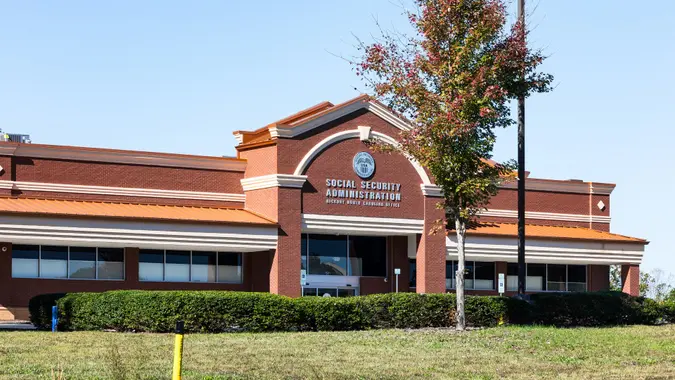What the Trump Administration Could Mean for Social Security Insolvency

Commitment to Our Readers
GOBankingRates' editorial team is committed to bringing you unbiased reviews and information. We use data-driven methodologies to evaluate financial products and services - our reviews and ratings are not influenced by advertisers. You can read more about our editorial guidelines and our products and services review methodology.

20 Years
Helping You Live Richer

Reviewed
by Experts

Trusted by
Millions of Readers
Social Security, the mainstay retirement program for millions of Americans, faces a financial countdown toward insolvency within the next decade. Questions swirl over whether policies introduced by President Donald Trump in 2025 could speed up Social Security’s financial troubles.
For context, Committee for a Responsible Federal Budget (CRFB) analysis shows Social Security’s trust fund would become insolvent in 2031, three years earlier than currently projected by the Congressional Budget Office (CBO).
But could it be that Trump’s initiatives accelerate that insolvency date? Because, at that point, the program would need to cut benefits by 33%, a steeper decrease than the 23% reduction forecast by the CBO in August. Millions of beneficiaries might experience very painful benefit cuts years earlier than expected, and this is why it could happen.
Trump’s 2025 Social Security-Related Policies
Trump’s administration has implemented significant changes to Social Security since taking office in January 2025. The administration expedited the implementation of the Social Security Fairness Act, promising quicker delivery of benefits to eligible recipients across America.
For example, the Social Security Administration (SSA) announced in February that retroactive payments for affected beneficiaries would begin as early as March 2025. According to the SSA, changes to monthly benefits will start in April, much faster than their initial timeline suggested for full nationwide implementation.
NPR reported that the Trump administration announced plans to cut approximately 7,000 jobs at the SSA in early 2025. This staffing reduction comes as the agency is “operating at its lowest levels in 50 years, catering to more Americans than ever.” The president also plans to eliminate income taxes on Social Security benefits, overtime pay and tipped income, measures intended to boost workers’ take-home pay.
However, by eliminating these taxes, Trump’s plan would cut off certain revenue streams that currently fund Social Security. Cutting down on staffing could also impact service delivery even before the insolvency issue becomes acute.
Concerns About Insolvency
Trump has repeatedly promised to protect Social Security without benefit cuts or tax increases on the program, though he has not specified exactly how this would be achieved. In Trump’s view, pro-growth policies will boost payroll tax revenue enough to sustain Social Security’s benefits.
However, many economists and budget experts are skeptical that economic growth alone can resolve Social Security’s long-term funding gap.
Shannon Benton, executive director of The Senior Citizens League, said that without a concrete plan to address Social Security’s shortfall, insolvency could accelerate dramatically. Benton explained that a resulting 21% across-the-board benefit cut would “likely lead to a spike in poverty rates for older Americans and low-income workers. This will particularly affect the approximately 40% of seniors who rely solely on Social Security for their income.”
The nonpartisan CRFB analyzed Trump’s plans and found they could hasten the program’s insolvency. They estimate that these changes would advance the trust fund’s depletion by roughly three years — from 2034 to 2031. For perspective, CRFB calculated that Trump’s agenda would add roughly $2.3 trillion to Social Security’s deficits over the next decade.
One concern is that Trump’s Social Security tax changes would not benefit all retirees equally across different income levels.
“Eliminating taxes on Social Security benefits would benefit higher-earning retirees who currently pay income taxes,” Benton explained.
Lower-income beneficiaries typically don’t pay federal income taxes on their benefits due to their overall limited income from all sources.
Potential Solutions To Strengthen Social Security
Most experts agree that ensuring Social Security’s long-term solvency will require some mix of raising revenue and reducing benefits. Potential reform options include raising payroll taxes by lifting the cap on taxable wages and raising the retirement age for beneficiaries. Some have floated new revenue sources, such as dedicating general tax revenue to the program, to strengthen it without cutting benefits.
Any major Social Security reform will require political compromise — something that has been hard to achieve, so far. Social Security’s popularity has made lawmakers reluctant to consider benefit cuts or tax increases, leaving the program’s problems unresolved.
Benton suggested that a bipartisan solution balancing financial sustainability with benefit protection is necessary to secure Social Security’s future.
Editor’s note on political coverage: GOBankingRates is nonpartisan and strives to cover all aspects of the economy objectively and present balanced reports on politically focused finance stories. You can find more coverage of this topic on GOBankingRates.com.
More From GOBankingRates
 Written by
Written by  Edited by
Edited by 
























